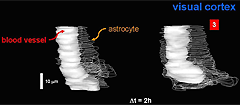
Laboratory for Molecular Neuroscience
Group home page at UiO
Group home page (old)
Nordic Centre for Water Imbalance Releated Disorders (WIRED)
The Laboratory for Molecular Neuroscience investigates molecular mechanisms involved in the development of acute and chronic neurodegenerative disease, with a focus on the role of glutamate excitotoxicity. It aims at unravelling the molecular basis for cell death and edema development in stroke and other neurological conditions, and explores the pathophysiology of Alzheimer’s disease and temporal lobe epilepsy. Long term goals are to identify new molecular targets for neuroprotective strategies in stroke and other conditions involving glutamate excitotoxicity and to unravel the physiological and pathophysiological roles of astrocyte endfeet.
Challenges
Neurology continues to lag behind other disciplines when it comes to the range and efficacy of therapeutic strategies. In particular, common neurological conditions such as stroke, Alzheimer’s disease, and other acute or chronic neurodegenerative diseases call for new therapeutic strategies. Several of these conditions are particularly prevalent among the elderly and will constitute a growing health concern as the population ages. The challenge is to identify new principles of treatment for these diseases.
Projects
- Assessing the role of water channel molecules (aquaporins) in the development of brain edema and in the regulation of ion homeostasis in brain extracellular fluid.
- Exploration of the composition and function of the protein complexes that interact with glutamate receptors and that mediate downstream signalling from these.
- Unravelling the synaptic expression of kainate, NMDA, and AMPA receptors and the mechanisms responsible for their turnover.
- Identification of mechanisms underlying loss of glutamate homeostasis in temporal lobe epilepsy.
- Exploration of mechanisms involved in the formation of beta-amyloid in aging and Alzheimer’s disease
Recent achievements
Resolving modes of NMDA and AMPA receptor expression in hippocampal spine synapses (Nature Neuroscience 2:618-624, 1999). Identification of principles underlying expression and regulation of the water channel aquaporin-4 in the CNS (J Neurosci 17:171-80, 1997; J Neurosci 21:3045-51, 2001; PNAS 98:14108-13, 2001). Showing that removal of perivascular aquaporin-4 protects against development of postischemic edema and delays K+ clearance from the extracellular space (PNAS 100:2106-11, 2003; PNAS, 100:13615-20, 2003, Nature Reviews Neuroscience, 4:991-1001, 2003). Identification of neuronal plasma membrane microdomains that colocalize beta-amyloid and presenilin (Neuroscience, 120:291-300, 2003). Demonstrating loss of glutamine synthetase and perivascular aquaporin-4 in patients with temporal lobe epilepsy (Lancet, 363:28-37, 2004; PNAS 102:1193-8, 2005). Unravelling the molecular organization and function of astrocyte endfeet (PNAS 102: 8030-5, 2005; PNAS 103: 13532 – 6, 2006).
Group leader
 Research scientist Mahmood Amiry-Moghaddam
Research scientist Mahmood Amiry-Moghaddam
Department of Anatomy & CMBN
University of Oslo
PO Box 1105 Blindern
NO-0317 Oslo
Norway
Tel: +47 22851273
Fax: +47 22851278
E-mail: m.r.amiry-moghaddam@medisin.uio.no
This group was formerly led by Ole Petter Ottersen.

Swelling of astrocyte, monitored in a living mouse 2h after induction of hypo-osmotic stress. Transcranial multi photon in vivo imaging (courtesy of Gabriele Nase and Johannes Helm).
PO Box 1105 Blindern, NO-0317 Oslo, Norway. Tel: +47 22851528. Fax: +47 22851488